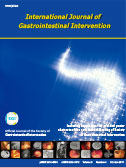
pISSN 2636-0004
eISSN 2636-0012
ABOUT THE IJGII
ARTICLE CATEGORY
ALL ARTICLES
For Contributors
-
POLICY



 pISSN 2636-0004
eISSN 2636-0012
pISSN 2636-0004
eISSN 2636-0012
 All Articles
All Articles
 Articles
Articles

Abstract : Malignant gastric outlet obstruction is most commonly seen in the patients with cancers of the pancreas, gallbladder, biliary tree, stomach, and duodenum. The placement of self-expanding metal stents under fluoroscopy or endoscopy has proven to be an alternative to surgical treatment and to have the advantages of being less invasive, having a lower complication rate, and allowing a quicker recovery. In this review article, we provide an overview of current fluoroscopic and endoscopic stenting practice for gastric outlet obstruction with regard to stent design and stenting procedure, efficacy, and complications, and compare stenting and surgery.
Cited By: 5

Abstract : The management of patients with small bowel obstruction distal to the third part of the duodenum and altered gastrointestinal anatomy is challenging. Until recently, surgery had been the mainstay of treatment for obstruction, which had however posed a risk of serious complications. The difficulty with the endoscopic approach in the deep area of the intestine and the blind end of the altered gastrointestinal anatomy could be a possible reason. Recently, the advent of overtube-assisted endoscopy has radically facilitated endoscopic interventions such as balloon dilation for benign obstructions or placement of self-expanding metal stents for malignant obstructions. Advanced endoscopic therapy for small bowel stricture or choledochojejunal anastomotic stricture has become a safe and effective method.
Cited By: 1

Abstract : Endoscopic stenting with a self-expandable metallic stent (SEMS) is widely accepted for the management of malignant colorectal obstruction (MCRO). This procedure is effective for both palliative purposes and as a bridge to surgery. MCRO can arise from colorectal cancer (CRC) or advanced extracolonic malignancy (ECM), including gastric, pancreatobiliary, small bowel, endometrial gynecologic, or urinary malignancies. In patients with an ECM, the pathogenesis of obstruction is different from that of CRC and is caused by direct tumor invasion into the lumen or extrinsic compression at an advanced stage. These differences and the advanced clinical condition can influence the clinical results. Endoscopic colonic stenting for ECM has lower technical and clinical success rates than for CRC. Appropriate patient selection and technical issues are key to improved outcomes. In the near future, a prospective clinical trial should evaluate the efficacy and safety of SEMS placement for MCRO caused by ECM.
Cited By: 4

Abstract : Embolization of the left gastric artery with the intent of decreasing hunger, termed bariatric embolization, has experienced a recent surge of attention in the literature and at medical conferences. This endovascular treatment for obesity has demonstrated promising data as a potentially new and effective minimally invasive treatment for obesity. The goal of this review article is to discuss the background, rationale, and existing data on this new topic.
Cited By: 1

Abstract : Interventions for infected and symptomatic walled-off pancreatic necrosis (WOPN) have undergone a paradigm shift away from open surgical necrosectomy toward endoscopic intervention such as transmural drainage and necrosectomy. Recent multicenter studies and evidence-based guidelines have suggested the safety and efficacy of endoscopic transmural necrosectomy (ETN) for management of complicated WOPN. In consideration of the inherent properties and the risks associated with this procedure, ETN should be performed by expert endoscopists who are well-versed in management of necrotizing pancreatitis and supported by a special multidisciplinary team. Although there have been limited data to define the selection criteria and the techniques regarding ETN, this comprehensive review focuses on the current indications, therapeutic outcomes, complications, and controversies of ETN for management of WOPN.
Cited By: 5

Abstract :
Cited By: 3

Abstract :
Cited By: 2

Abstract :
Cited By: 3

Abstract :
Cited By: 2

Abstract : Carcinoid tumors are neoplasms that are seen in all portions of the gastrointestinal tract. In some instances, primary tumors can go undiagnosed or misdiagnosed owing to nonspecific presenting symptoms. In this case report we discuss a patient with vague abdominal symptoms and radiographic findings previously attributed to Crohn’s disease, who at operative exploration was found to have a metastatic carcinoid tumor. This report demonstrates the nonspecific nature of metastatic carcinoid tumor and how its presentation can masquerade as more common gastrointestinal system abnormalities.
Cited By: 0

Hyung Ku Chon  and Seong-Hun Kim
and Seong-Hun Kim 
Int J Gastrointest Interv 2023; 12(1): 7-15
https://doi.org/10.18528/ijgii220037
Se Hwan Kwon  , Seung Yeon Noh
, Seung Yeon Noh  , and Joo Hyeong Oh
, and Joo Hyeong Oh 
Int J Gastrointest Interv 2023; 12(1): 37-42
https://doi.org/10.18528/ijgii220005
Int J Gastrointest Interv 2023; 12(2): 57-63
https://doi.org/10.18528/ijgii220004
Partha Mandal  , Barrett P. O'Donnell
, Barrett P. O'Donnell  , Eric Reuben Smith
, Eric Reuben Smith  , Osamah Al-Bayati
, Osamah Al-Bayati  , Adam Khalil
, Adam Khalil  , Serena Jen
, Serena Jen  , Mario Vela
, Mario Vela  , and Jorge Lopera
, and Jorge Lopera 
Int J Gastrointest Interv 2022; 11(1): 18-23
https://doi.org/10.18528/ijgii210028
Int J Gastrointest Interv 2021; 10(3): 96-100
https://doi.org/10.18528/ijgii210032
Dominic Andre Staudenmann  , Ellie Patricia Skacel
, Ellie Patricia Skacel  , Tatiana Tsoutsman
, Tatiana Tsoutsman  , Arthur John Kaffes
, Arthur John Kaffes  , and Payal Saxena
, and Payal Saxena 
Int J Gastrointest Interv 2021; 10(3): 128-132
https://doi.org/10.18528/ijgii200050


 pISSN 2636-0004
eISSN 2636-0012
pISSN 2636-0004
eISSN 2636-0012
| TODAY | 137 |
|---|---|
| TOTAL | 227,585 |
© The Society of Gastrointestinal Intervention. Powered by INFOrang Co., Ltd.